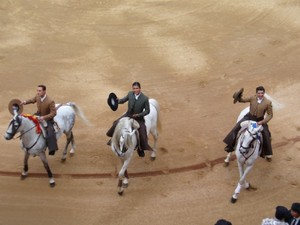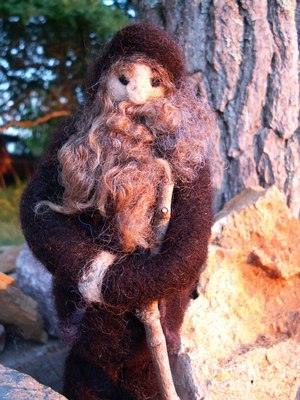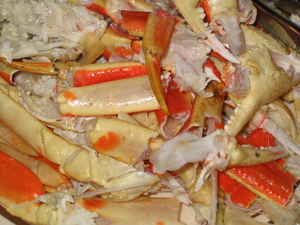This version of a bullfight is not the classic Spanish version, with the heroic matador (killer) displaying his panache and bravado by putting himself in danger of goring while expertly bringing down a beast more than four times his size. Nor are there any picadors, or “piercers,” who enrage the bull with needle-like daggers. No, this bullfight is another, less iconic version referred to in Spain as a rejoneo, which could be translated “lance rodeo.” In it, six horsemen display their riding skill while bringing down a bull with different lances. In Ecuador, any version of a bullfight is called la corrida de los toros, which means something like “bull run.” In fact, the English term “bull fight” is a misnomer; the event is not viewed as a face-off between man and beast, but a ritualized display of skill. Still, there is a distinct sense that las corridas play to the baser human instincts of bloodlust, a fact which as at the heart of the controversy within Latin cultures.
Having received all my exposure to bullfights from Merry Melodies cartoons, I have decided to come to the plaza to test my bullfighting knowledge…as well as my bullfighting tolerance. The plaza is a perfect circle, with three tiers, and six sections, one for each bull that will be killed tonight. It is a festival day in Riobamba, Ecuador, celebrating Riobamba’s first attempt at independence, on November 11, that preceded the successful attempt on April 21. Only during these two holiday periods are bullfights conducted. They seem to be losing popularity with the younger crowd, who increasingly consider them brutal and inhumane, but I suspect these events will be carried on for years in the name of tradition, regardless of ticket sales.
The sand in the arena is being raked and watered down for the event, and a large red circle is drawn around the arena in the same manner as a baseball diamond. A large military brass band takes their designated seats in a section of general seating. The event kicks off with what sounds like patriotic hymns, for which the crowd stands and sings. Then everyone cheers, sits down, and the bullfighting music starts, which is clearly Spanish and not Ecuadorean. Traditional Spanish music is marked by thick textures and instrumentation, in this case a host of brass belting patriotic hymns. Ecuadorean music is more spritely, with panpipes and ukulele-like instruments called churangos. As well as having its own type of music, an Ecuadorean bullfight seems to have its own special beer, Brahma, as opposed to Pilsener, the Ecuadorean beer of everything else.
The Merry-Melodies-style “bullfighters” emerge with their ornate costumes, pink socks, ballerina shoes, weird sideways hats, and red curtains in their hands. They are generically called toreros, and their role is distraction while the horses and horsemen rest between the three main stages, or terceros, of the event. These horsemen are the real bullfighters in a rejoneo-the one’s who will maim and kill the bull. They are handsomely dressed horsemen with Latin-style chaps, cowboy hats, and snappy vests. Three of them enter the arena at the sound of the introductory fanfare, mounted on large, beautiful white warhorses. The dancing horses trot in the rhythm of the fanfare, toward the boundaries of the arena, face the crowd, and sidestep in a row around the arena while the horsemen wave their hats at the crowd, to much applause. The horsemen then guide their steeds in and out of formations, performing fancy trots and dances that elicit many ooh’s and ahh’s.
Then a man runs out with a sign, including the name of the horseman, the name of the bull, and the bulls’ weight. The first bull, Faraon, weighs over 900lbs. The man with the sign runs out of the arena, the music starts again, and the three horsemen return, this time with a fourth horseman on a black horse. The symbolism is clear. Demonstrating ritualized showmanship, one of the horsemen takes a red- and white-colored spear with a small two-inch blade from a man on the side of the arena, then holds it up and gallops around for the crowd. He then hands the spear to the black horseman, and hugs him to show deference. The other horsemen also make a show of hugging him. More cheers.
Music starts again as a portal is opened to the bull corridor through which Faraon rushes out with his prize ribbon on his back. The toreros scurry out with their capes and wave them at the bull, then run behind their little barricades as the bull approaches, inducing the bull to run around the arena and display its ferocity. At times the bull will stop in front of the barricade and wonder where the little man ran off to, in which case the man will reach over the barricade and tap the bull on the head to rile him up some more, and often induce him to gore the wooden barricade. The toreros, rushing in and out of their safe spots, waving flags with their ballerina costumes are behaving more like the jesters they resemble than the bullfighters I expected. The bull finally stops in the middle, looking confused and alert, with the sense that this is what he has been prepared for all his life. In comes the horseman to signal the beginning of the first stage.
He is given a colorful spear, one at a time, from the side of the arena, two white and one red, called rejones de castiga, “lances of punishment.” He rides around the arena, inducing the bull to chase after his horse, and riding in such a way that the bull just barely misses the hind haunches of his horse with his horns, eliciting gasps from the audience. Finally, he leans over and, with a swoop of an arm, sticks the spear into the bull, aiming for the hump on his back just above the neck. The spearhead breaks off in the flesh of the bull and a red flag unravels in its place, which the horseman waves in front of the agitated bull’s face as he charges the horse around the arena. The crowd is pleased. After the three of these spears are broken off in the bull’s flesh, the toreros come out from their foxholes do their slight-of-hand tricks and fancy-footed dances while the horseman rides out of the arena. The blood starts to run down the legs of the bull. The cape effectivley distracts the bull, who, if he had a chance to gain more experience, might eventually figure out the little man is never behind the red cape, but always to the side.
The horseman returns, and this time, the stickers are more colorful and ornate, called banderillas, “little flags,” and they adorn the bull’s hump once inserted. These little decorated blades become increasingly shorter, forcing the horseman to get ever closer to the bull to insert them. The highly trained horseman on his highly trained horse can easily reach back and place a hand on the charging bull. The real skill comes in sticking the bull precisely, while the horse sidesteps. Sometimes the horseman will show off by pinning a lapel of roses at the end of a four-inch blade to the bull’s back or taking off his hat and placing it on the bulls head before removing it again. One horseman stuck two lances into the bull at once, one from each hand. These stunts are effective with the crowd.
In the end, there are 9-12 blades in the bull’s back, and the bull’s front flank is caked in blood. The bull never grunts or squeals, but he has obviously been weakened. Finally, the music comes up again, in a more ominous tone, as the horseman is handed the final spear, the rejon de muerte, “lance of death,” with a fatal 16-inch blade. The goal of this blade is to sever the bull’s spine, killing him in one blow. That is, if the horseman’s accuracy is precise. The horseman does some more showing off as the bull pursues him, then sticks in the final spear to the din of the crowd. At this point, it is the toreros’ duty to test the damage done by the blow. They come out in twos, flashing their red capes, alternating between them to keep the bull running desperate circles and figure eights. After about a minute of this, Faroan, the smallest bull of the night, suddenly starts coughing up blood as he falls to his knees, and the crowd generously applauds the fatality of the blow. Now that the bull is weak enough to approach, a torero with a dagger nears the bull to stick it into the back of the bull’s skull and stir it around until the bull stops moving entirely, and a man in black who looks like an evil twin of a musketeer comes out to cut off the bull’s ear, which he hands to the horseman as a trophy. A two-wheeled trailer cart is brought out, to which the bull’s neck is chained, and which is hitched to the back of two black horses so that it can be dragged out of the arena in a trail of blood. The blood is raked over by attendants. The horseman returns on foot, to the cheers of the audience, and walks around the arena, with the toreros behind him, waving to the crowd as they throw roses and hats down to him. He throws the hats back, and sometimes dons one of them, the ultimate sign of appreciation to his fans.
Then the man with the sign returns again, the chalk erased and rewritten for the new bull and bullfighter, and the whole spectacle is repeated, with slight variations, five more times. What varies the most in this particular event is the efficiency of the killings.
The second bull requires additional jabs with the lance of death. The horseman only approaches the bull without his horse once the bull is on his knees. He glorifies each movement, bringing his weapon out from behind its red curtain, and plunging it into the bull’s head repeatedly, throwing his hands into the air in victory at the thud of the bull’s head in the sand, dancing around in front of the crowd to elicit cheers.
The third bull, cutely named Osito, which means “teddy bear” in Spanish, ended his life–before the toreros had a chance to wear him out–spewing blood from his mouth as he staggered back and forth across the arena, finally collapsing in a pool of his own blood. The crowd is very pleased with this ending, as is the bullfighter, who dismounts his horse to command the bull to death with exaggerated finger pointing and other antics matching in zeal the applause of the crowd. The applause is the greatest so far as the horseman slowly circles the arena in a display of cockiness, showered with roses, hats and scarves. His deathblow was apparently ideal.
Just after carting off the third bull and more sand raking than usual, the double-doors entrance to the arena is opened again, and to the great delight of the crowd, a group of dwarves come running out into the arena, wearing yellow shirts and doing acrobatics. “Ohhh, enanos!” squeals the woman behind me with delight. People here love little people. The dwarves do a few small acts, providing some comic relief, before toddling back out the doors.
The fourth horseman’s deathblow is too far to the bull’s rear, paralyzing only his hind legs. The bull drags his rear around in the sand with his front legs, while the toreros desperately try to kill him with lances and daggers. The cheers of the crowd turn into sneers and hisses as one torero sticks the dagger into the bull, timidly, one, two, three times, without effect. There is approval for another torero who finally finishes the job. The horseman makes a cursory parade for minimal cheers and walks away somewhat disgraced.
The preferred horseman returns to fight the fifth bull. But even after sticking the bull with 12 lances, it takes the horseman four strikes with the death lance before the bull is finally brought down. The horseman shows a great deal of frustration with his own performance, despite moderate cheers from the crowd. I am very impressed with the tenacity of this bull, and at this point I think it would be a more gentlemanly maneuver for the horseman to admit defeat, let the bull recover and be hailed as champion. After repeated spearings with the death lance and falling to his knees, my champion bull is approached by the torero with the dagger. I secretly hope the bull will get back up and chase the torero off. And so it happens. Three times. After the third time, the crowd is applauding more loudly for the bull than the bullfighter. Still, the bullfighter continues the ritual of killing the bull, using the same antics as before, although this time he looks absurd without the approval of the crowd.
At the end of five bull runs, it is obvious to me there is no real daring displayed by the horseman or the toreros in this exercise. The bull doesn’t stand a chance. The horse, at a sideways saunter, can outrun and outmaneuver the charging bull. The toreros are hardly in any more danger with the aid of their companieros, red capes and bull-proof dugouts. Often the bull tires and stands in the center with his decorations, ready to call it quits, tap out, and go rest somewhere. But that isn’t a good spectacle. A bullfight is foremost intended to be a spectacle. It is hardly intended to be a sportsmanlike fight, nor is it a fight. It isn’t even a sport. It is a bull run.
The opening promenade was an impressive enough spectacle and I enjoyed the display of equestrian prowess, but the event has become unpalatable for me and I see no virtue in remaining. So the bullfighting arena loses one more spectator as I decide I am hungrier for food than for blood. On arrival at the hotel restaurant, I am a little surprised to find that it is not beef for dinner, but chicken.




